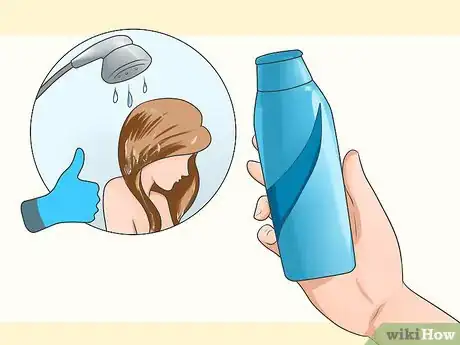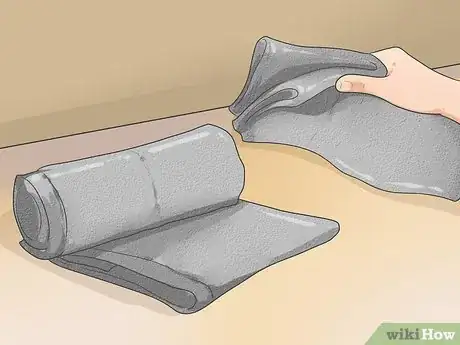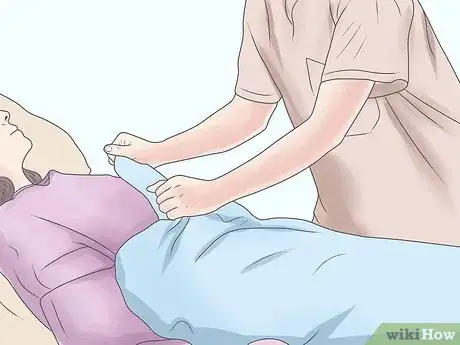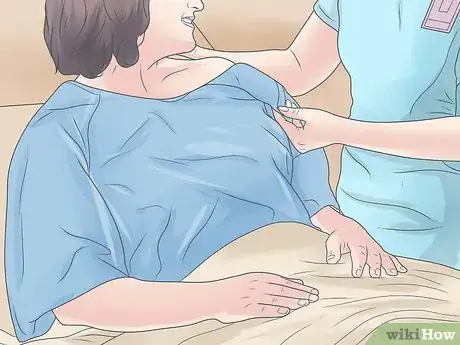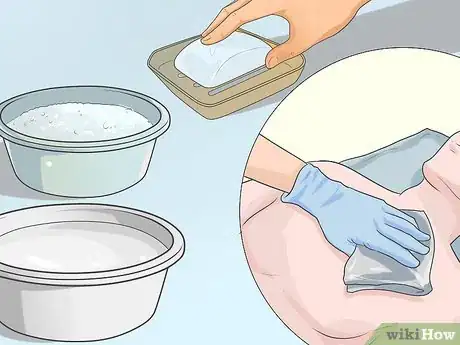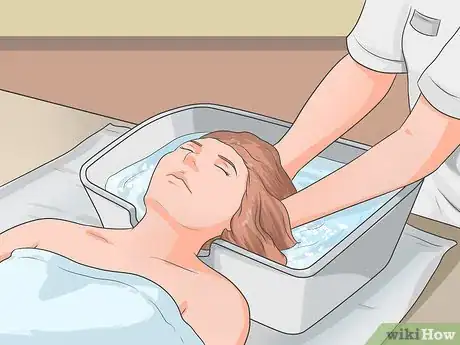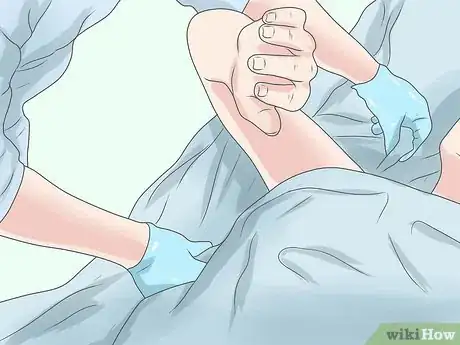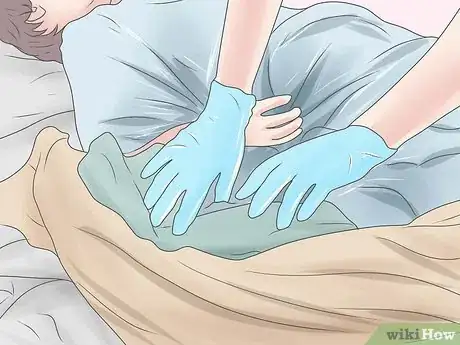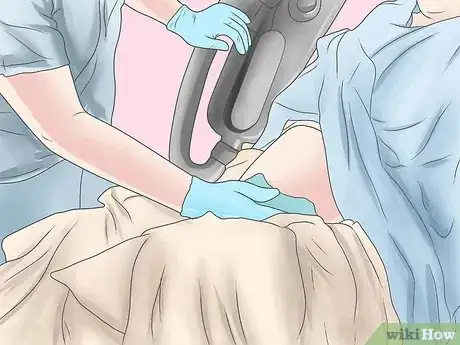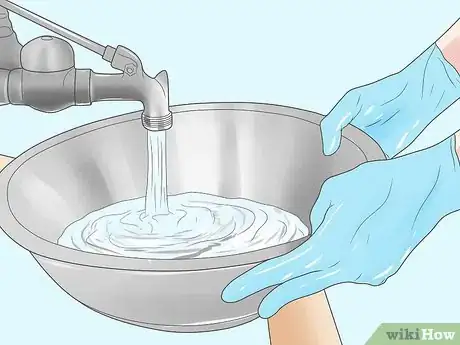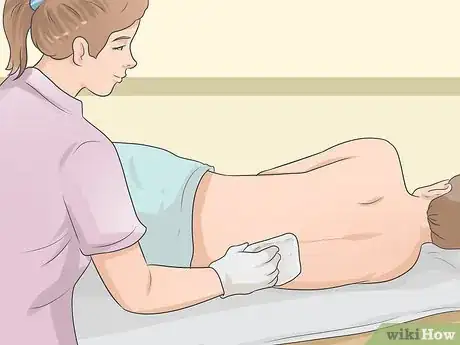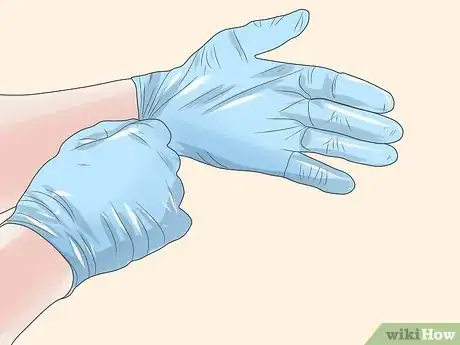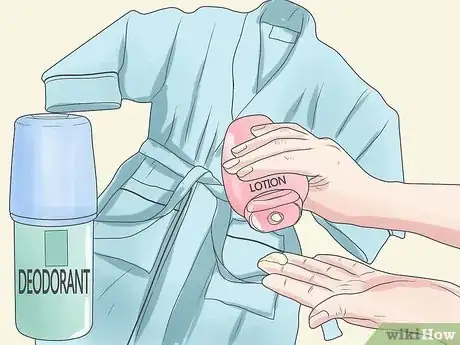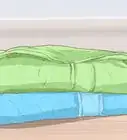wikiHow is a “wiki,” similar to Wikipedia, which means that many of our articles are co-written by multiple authors. To create this article, 19 people, some anonymous, worked to edit and improve it over time.
There are 8 references cited in this article, which can be found at the bottom of the page.
wikiHow marks an article as reader-approved once it receives enough positive feedback. This article received 16 testimonials and 91% of readers who voted found it helpful, earning it our reader-approved status.
This article has been viewed 448,348 times.
Learn more...
Sponge baths, or bed baths, are used to bathe people who are bedridden or unable to bathe on their own due to health reasons. Giving a bed bath involves washing and rinsing the entire body one section at a time while the patient remains in bed. It is important to gather all the supplies needed before you begin so you do not have to leave the patient unattended. A good bed bath will leave the person feeling clean and comfortable.
Things You Should Know
- Prepare your patient for the bath by laying them on towels, covering them with a sheet, and undressing them.
- Clean your patient by washing the skin with one washrag and rinsing it off with another. Work in sections, blotting each area dry as you go.
- Start the sponge bath by washing the patient's face, hair, shoulders, arms, torso, and legs.
- Complete the bath by washing the patient's back, buttocks, and genitals.
Steps
Preparing to Give the Bath
-
1Fill two basins or washtubs with warm water. One is used for washing, and the other for rinsing. The water temperature should be 115 degrees F (46 degrees C) or less. You want it to be comfortable to the touch, but not too hot.[1]
-
2Choose a soap that's easy to rinse away. Most bar soaps are fine to use. Body washes are also acceptable as long as they don't leave a residue. You may add soap to one of the basins to create a bowl of warm, soapy water for washing, or keep the soap separate and apply it directly to the patient's skin.[2]
- Avoid using soap that has exfoliating beads or other substances that could end up staying on the patient's skin and causing irritation.
- No-rinse soaps are available at drug stores. This is a convenient solution for a quick cleanse, but they leave a residue so you'll still need to rinse the patient's body from time to time.
Advertisement -
3Get shampooing supplies ready. If you plan to shampoo the patient's hair, you'll need a shampoo that's easy to rinse out (such as baby shampoo) and a special basin designed for washing hair in bed. You can find one at a medical supply store, and it's a big help when it comes to washing hair in bed without getting water everywhere.[3]
- If you don't have a special basin, you can make do by placing an extra towel or two under the patient's head to protect the bed from getting too wet.
-
4Have a stack of clean towels and washcloths ready. At minimum, you'll need three large towels and two washcloths, but it's nice to have extra in case there's a spill or the supplies get soiled.[4]
- It's convenient to stack towels, washcloths, water basins, and soap on a portable cart, such as a TV cart, so you can keep everything you need close to the bed.
-
5Place two towels under the patient. This will prevent the bed from getting wet and keep the patient comfortable during the process. To place the towels under the patient, lift the patient onto their side and scoot the towel under, then carefully lower the patient and do the same on the other side.[5]
-
6Cover the patient with a clean sheet or towel. This will ensure the patient stays warm during the bath as well as provide some privacy. The sheet or towel will stay on the patient's body the whole time.[6]
- Be sure to adjust the temperature in the room if necessary, to prevent the patient from getting a chill.
-
7Remove the patient's clothes. Fold down the sheet or towel, uncover the patient's top half, and remove their shirt. Replace the sheet over the top half of the patient. Fold the sheet back from the patient's legs and remove their pants and underwear. Recover the patient with the sheet.[7]
- Try to keep as much of the patient covered as possible while you're removing the clothes.
- Keep in mind that this process can be embarrassing for some people, so try to work quickly and with a purposeful attitude.
Bathing the Head, Chest, and Legs
-
1Use the same cleansing and rinsing method for the whole body. First, apply soap or soapy water to the patient's skin. Scrub it gently with a washcloth to remove dirt and bacteria, then place the washcloth in the soapy basin. Dip a second washcloth into the rinsing basin and use it to rinse away the soap. Pat the area dry with a towel.[8]
- Remember to rotate between the two washcloths: use one for soaping and one for rinsing. If the clothes become soiled, switch to clean ones.
- Replace the water in the basins as necessary.
-
2Start with the patient's face. Gently wash the patient's face, ears, and neck with soapy water. Rinse away the soap with a separate washcloth. Dry the cleaned area with a towel.[9]
-
3Wash the patient's hair. Gently lift their head into the shampooing basin. Wet the hair by pouring water over the patient's head, taking care not to get it in their eyes. Apply shampoo, then rinse it away. Pat the hair dry with a towel.[10]
-
4Wash the patient's left arm and shoulder. Fold over the sheet on the left side of the body down to the hip. Place a towel beneath the exposed arm. Wash and rinse the patient's shoulder, underarm, arm, and hand. Dry the wet areas with a towel.[11]
- Dry the washed areas thoroughly, especially the underarm, to prevent chafing and bacteria growth.
- Recover with the sheet to keep the patient warm.
-
5Wash the patient's right arm and shoulder. Fold over the sheet to expose the right side. Place the towel beneath the other arm and repeat, washing, rinsing and drying the right shoulder, underarm, arm, and hand.
- Dry the washed areas thoroughly, especially the underarm, to prevent chafing and bacteria growth.
- Recover with the sheet to keep the patient warm.
-
6Wash the patient's torso. Fold the sheet down to the waist and gently wash and rinse the chest, stomach, and sides. Be sure to wash carefully among any folds in the patient's skin, since bacteria tends to get trapped there. Dry the torso carefully, especially among the folds.[12]
- Recover the patient with the sheet to keep the patient warm.
-
7Wash the patient's legs. Uncover the patient's right leg up to the waist, and wash, rinse and dry the leg and foot. Recover the right leg and uncover the left, then wash, rinse and dry the leg and foot. Recover the lower half of the body.[13]
Bathing the Back and Private Area
-
1Empty the water basins and refill them with clean water. Since approximately half the patient's body is now clean, it's a good time to refill the water.
-
2Ask the patient to roll on their side if they are able. You may have to assist the person. Make sure they are not too close to the edge of the bed.
-
3Wash the patient's back and buttocks. Fold the sheet over to expose the entire backside of the patient. Wash, rinse, and dry the back of the patient's neck, back, buttocks, and parts of the legs you may have missed.[14]
-
4Wash the genital area and anus. Put on latex gloves if desired. Lift the person's leg and wash from front to back. Use a clean washcloth to rinse the area. Be sure to clean thoroughly between folds, and dry the area thoroughly as well.[15]
- Males should be washed behind the testicles. Wash a female's labia, but there's no need to clean the vagina.
- This part of the body should be washed every day, even when you're not giving a full-body bed bath.
-
5Redress the patient. When you're finished, dress the patient in clean clothes or a robe. First replace the patient's shirt, keeping the sheet over his or her legs. Then remove the sheet and replace the person's underwear and pants.[16]
- Elderly skin tends to get dry, so you may want to apply lotion to the arms and legs before putting their clothes back on.
- Comb the person's hair and apply cosmetics and other body products according to the patient's preferences.
Things You'll Need
- Basin or washtub
- Warm water
- Sheet
- Blanket
- Mild soap
- 6 washcloths (2 for face, 2 for body, 2 for peri care)
- 2 large towels (1 for the body, 1 for peri care)
- Disposable gloves
- Grooming products such as deodorant and lotion
References
- ↑ https://www.wsj.com/articles/burning-question-what-is-the-best-water-temperature-for-your-bath-or-shower-1451931152
- ↑ https://www.generationsolutions.net/three-common-questions-about-bathing-the-elderly/
- ↑ https://www.peacehealth.org/medical-topics/id/abp9705
- ↑ http://www.nlm.nih.gov/medlineplus/ency/patientinstructions/000427.htm
- ↑ https://www.youtube.com/watch?v=9VKox-wy4fU
- ↑ https://caregiverconnection.org/giving-elder-sponge-bath-with-dignity/
- ↑ http://www.agingcare.com/Questions/sponge-bather-elderly-patients-142973.htm
- ↑ https://www.peacehealth.org/medical-topics/id/abp9705
- ↑ https://www.peacehealth.org/medical-topics/id/abp9705
- ↑ https://www.peacehealth.org/medical-topics/id/abp9705
- ↑ https://www.peacehealth.org/medical-topics/id/abp9705
- ↑ https://www.peacehealth.org/medical-topics/id/abp9705
- ↑ https://www.peacehealth.org/medical-topics/id/abp9705
- ↑ https://www.youtube.com/watch?v=9VKox-wy4fU
- ↑ https://www.youtube.com/watch?v=9VKox-wy4fU
- ↑ https://www.nia.nih.gov/health/bathing-dressing-and-grooming-alzheimers-caregiving-tips
About This Article
Before you give someone a sponge bath, fill a basin with soapy water and another basin with plain water. Then, soak a washcloth in the soapy water and use it to wash the person's body. Next, dip a second, clean washcloth in the basin of plain water rinse the soap off with it. Repeat that process on each section of the person’s body, patting them dry as you go. Scroll down to learn how to wash their hair, and for advice on how to clean specific parts of a person’s body.


